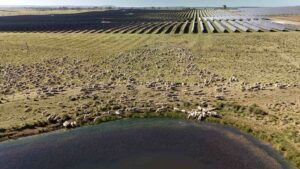
On Friday Australian energy ministers agreed to an investigation into the country’s energy security, stability, and affordability to be led by Commonwealth Chief Scientist Alan Finkel. While any decisions as to how to ensure the stability of Australia’s electricity grid are unlikely to be made before then, large-scale electrical storage could very well have a significant role to play.
In what he hailed as “a real breakthrough,” federal energy minister Josh Frydenberg got the agreement of state and territory governments to place the security of electricity supply, and grids, front-and-center. The move came on the back of the statewide South Australian blackout less than a fortnight ago.
While it is unclear what conclusions Finkel, assisted by two as yet undetermined market experts, will reach, either distributed or utility-scale battery storage could be ideally placed to provide solutions for the grid.
Taking questions from the assembled media after the Ministers’ meeting in Melbourne last Friday, Frydenberg said that a CSIRO presentation about battery storage at the meeting “was really exciting” regarding the opportunities such solutions present.
“We did have discussions today about developing a greater market for frequency control and ancillary services,” said Frydenberg. “This is because, as was pointed out to us today by AEMO [the Australian Electricity Market Operator], historically inertia, which is so important in the system, has been a free good, and suddenly it is in more demand with intermittent generation.”
As has emerged in AEMO’s initial findings as to why South Australian statewide “System Black” event occurred, one the principal causes was a loss of grid frequency. This was itself the result of a number of interconnectors being felled by a severe storm and then a series of wind installations in the state going offline. Grid frequency regulation, otherwise known as grid inertia, is traditionally supplied by the thermal generators, by virtue of the kinetic energy stored in their large rotating masses.
However, large scale battery storage can also be called upon to supply frequency regulation services on electricity grids. There is also evidence to suggest that battery storage is superior to thermal turbines in supplying frequency regulation due to close to immediate response times.
Utility scale battery storage for frequency regulation is a fast evolving market globally, although its emergence is dependent on there being a market into which battery developers can bid. In fact, given various battery technologies’ relative immaturity and high costs, the economic competitiveness of a large scale battery array is enhanced if there are more than one use cases and therefore revenue streams for the system. These can be short-term power backup, peak demand shaving and frequency regulation.
The ability to supplant electricity substation upgrades through installing a large scale battery system is rapidly emerging as a compelling use case, and RenewEconomy understands that at least one large scale project is being developed in an Australian capital city at present.
Some U.S. jurisdictions have been particularly attractive to large scale storage developers, as has Japan in the wake of the energy challenges it has faced after the Fukushima-Daiichi nuclear disaster. Germany too is deploying large scale battery storage for frequency regulation at scale as renewable penetration in the country continues to increase, and despite its relatively robust grid.

Steag, which operates coal alongside renewable generation assets, is investing €100 million (AU$147 million) in a 90MWp/140MWh battery project across six sites in Germany, which will employ LG Chem’s lithium-ion batteries. The battery units will provide frequency regulation services to the grid and are being developed on an unsubsidized basis.
Australia is as yet to have deployed utility scale storage on the NEM for auxiliary service purposes. However, some island grids have installed battery arrays allowing them to turn off expensive and polluting diesel generators. In some cases, these battery systems are even able to “black start” or energize the grid in the event of an outage.
Western Australian has some islanded grids due to its vast geography, and its principal network is not physically connected to the National Energy Market (NEM). WA Energy Minister Mike Nahan addressed the media immediately after the COAG meeting’s conclusion, saying that battery storage will have a “profound” role in providing grid stability services in the systems of the future. WA’s regional utility Horizon Power has been particularly aggressive in developing battery storage on some of its isolated grids and is testing some 20 different battery storage systems.
“It is experimental, but at Horizon it is also cost effective,” said Nahan. The WA Energy Minister, who has been particularly open to the possibilities of distributed generation and battery storage given these technologies’ rapidly falling costs, said that market-based mechanisms could be created to facilitate battery deployment.
“We definitely have to look at incentives for battery storage, battery trading and other types of storage,” said Nahan. He noted that Australia’s electricity system is “evolving towards a decentralized system away from a “centralized, plant system.”
“It is very fascinating for wonks who like this, but it is where we are going and we have to evolve with incentives rather than with dictates,” said Nahan.
Frydenberg said that ARENA “and other bodies” are investing heavily in battery storage R&D. However, he argued that “some of those developments are some way away.”
The preliminary findings of Finkel’s investigation will be delivered ahead of the COAG Energy Ministers’ meeting in December.










